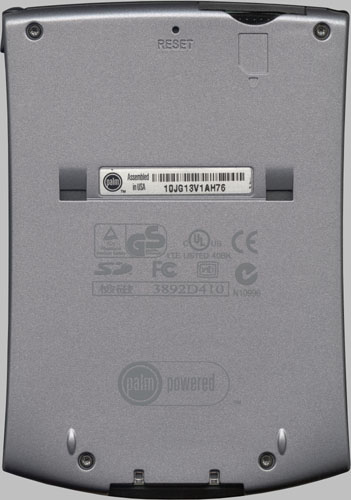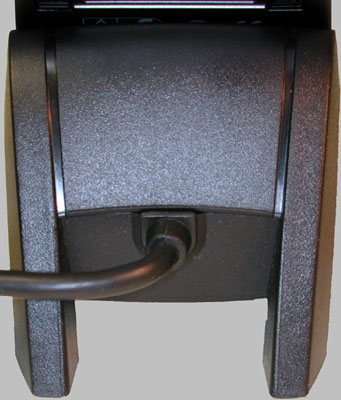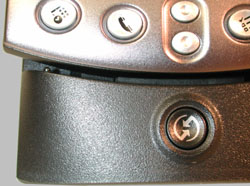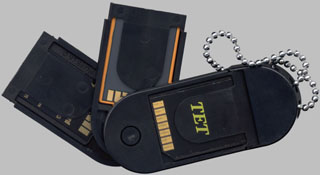| The Palm m500 |
 |
|
What's different? . This review will be relatively short. But not because there're no news, but because the m500 is so similar to the m505. All the common m500 series news can be found there. If you didn't read anything about the new Palms yet, it's a good idea to read the m505 review first. In this review here I will compare the m500 to m505 alot, since the relevant question if you plan to get a new Palm in the moment seems to be: m500 or m505? . |
 . . |
. |
|
|
| .
The most important obvious difference is the display. The m500 comes with the usual monochrome LCD and it weights a bit less than the m505. That's partly caused by the different screens, but surprisingly the m500 has also a different case. While the m505 is completely wrapped up in an aluminum case, the back of the m500 is made of aluminum colored plastic only. Another visual difference are the hardbuttons. The m500 has black ones, the m505 buttons are silvery which looks anyhow much more elegant. And I don't want to conceal that the m500 is exactly 1mm thinner than the m505. But that's about it with the mere formalities. . |
|
A technical look into the m500 . Although the mainboard of the m500 doesn't look much different from the m505 PCB, I couldn't resist to post an image. Call it for the galeries :) ... . |
 . . |
. |
| .
Well, there is at least one important difference: The display controller I singled out for praise in the m505 review is missing on the m500 board. Below the piezo you can see the empty space for the BGA case (Ball Grid Array) of the controller. The m500 also has to be content with a 20-pin connection to the display while the m505 color display needs 40 pins. Not that these 20 cables would mean anything physically, but it indicates, that the m505 display is controlled with a much wider data bus. Agreed, the color display needs more data, but most likely the wider bus helps also to speed up the communication. And I mentioned in the m505 review that the color display is 'snappier' than ever. Everthing else on the m500 board is the same: 33MHz VZ CPU, 8MB RAM, 4MB Flash, USB, serial drivers etc. etc. . |
 . . |
. |
| .
Don't misunderstand me, the m500 is good. It has the same quality as a PalmVx LCD, if not better. It has a slightly brighter background, so it seems to have an improved contrast. But once you used the TFT screen of the m505 for a while, _all_ monochrome displays seem to be 'dull'. The backlight of the m500 is more yellowish now, but has the same old problems in dim ambient light. And the backlight is another big plus for the color screen , it can be used anytime supporting the visibility. Whoever tried to use the backlight of a PalmVx in dim ambient light knows what I'm talking about. As a support before it is dark enough, the monochrome backlight is a pain or rather unusable. The m505 has of course an electronic contrast setting like the Palm Vx. But like the m100 for the first time, there's no extra hard button to pop up the contrast soft slider. Instead, there is a little symbol in the upper/right corner of the Graffiti area you have to tap. . The digitizer of the m500 is great. It's precise and sensitive, and the faster CPU seems to do good for the Graffiti recognition of the m500. Since the release of the m100, Palm seems to have mastered the digitizer function much better than in earlier units. . |
. |
| .
At first sight the cradle looks slim and elegant. There are two versions, one for the USB port and one for the serial RS-232 connection. By default, the m500 comes with the USB version only. If you need a serial cradle, you have to buy it extra for $29.95. Since the USB version costs $49.95, I assume the serial one comes without the power supply, considering you have to have one anyway if you bought an m500. Technically both versions are absolutely equal except the different cables. Both cradles don't contain any active parts and there are only different pins the different cables are connected to, that's all ... nearly. If you know where the hot end of a solder iron is, you can relatively easy convert your USB cradle into an RS-232 version. Read my description here. Both cradle versions are supplying charge power. The power supply is connected either to the RS-232 plug (serial version) or a little Y-extension of the USB plug at the end of the hotsync cable. That way the power supply and its cable stays completely under the table. . Optically quite nice, the m500 cradle is everything else than a good mechnical design, if not to say a pain to work with! Except some too small 'rails' which should obviously guide the little bumps in the back of the m500, there's no help to center the Palm over the connector. Additionally the new connector looks quite delicate (0.8mm pin pitch!), so blind fumbling while inserting the Palm hurts anyhow. Once you found the right position, a courageous push is needed to snap the Palm finally onto the cradle. But a real 'highlight' is the removal. The m500 can't be removed as usual pulling it just upward. You have to 'break' it free! When the Palm is tilted towards the front, a painful breaking sound produced by the two metal clips in the connector indicates that the unit is free now. Obviously even Palm realized that nobody will find that procedure intuitive, so they added a seperate little flyer, *explaining* how to remove the m500 ... I couldn't resist to post it here ... . |
 |
| .
Sorry Palm, but if you have to visually explain how to remove a PDA from the cradle, there is anyhow something wrong with the design! The real weird story is, that Palm burried an extra piece of metal inside the cradle to give it a good stand. Basically a nice idea which worked well in the PalmVx cradle. It weights about 110 of the 200 total grams, but it makes no sense at all. There had to be probaly a kilo of downforce to nail the cradle onto the table against the holding force of the connector. . |
 |
. |
| .
The images above are showing some details (click for a high-rez image). The idea was obviously, that the Palm is sitting on two little bumps left and right of the connector, but they are not reached. So the Palm rests on the connector. I don't understand why there is this gap anyway. If the connector would just sit a little lower, the m500 would rest perfectly on the curved cradle bottom and wouldn't 'float' above it. Unpleasant as it is, the mechanical construction seems to be quite solid. Both halfs of the connector snap-in mechanism (in the cradle and in the m500) are made of metal, so they'll survive probably much longer than the nasty sound suggests. Well, try it yourself and you'll agree with me, the cradle is basically a faulty design. . Electrically the cradle works well. The USB version speeds up the data transfer remarkable, although the theoretical transfer rate of USB 1.1 is by far not reached. Hotsyncing a 4300 kByte testfile took 86 seconds which gives a rate of about 50 kByte/sec. Even with a hotsync protocol overhead of 50%, the m500 USB makes use of only 10% of the possible speed of USB 1.1. But it's still much faster than an RS-232 connection and a regular hotsync hardly takes more than a few seconds. Another advantage of USB is its easy availability on modern PCs, while in doubt the two standard serials are already taken. The installation is absolutely troublefree and smooth, but you have to use the latest version of the Palm desktop. . |
. |
| .
Although there is lesser data to handle for the monochrome display, the m500 is not even faster than the m505. The extra color screen controller makes the m505 the snappiest Palm ever. And the future will be colored anyway. Already now you can find enough applications which look much more vivid in color, and there will be more soon. Even Palm supplies a multimedia viewer for images and little movies which looks quite dull on the monochrome screen. No doubt, the PDA future won't be black&white! . |
 |
. |
| .
It holds up to 3 SD- or MM-Cards and is really perfect to stow away the cards you just don't need. The function is best explained on the images (click to enlarge). Please don't ask me where you can get it, I have no idea, sorry. I got it as a present from a very good friend. But obviously it's produced by Hitachi, they are also producing MMCs. . |
|
. Last updated: June 15th, 2001 Copyright © 1997-2001 by Peter Strobel, all rights reserved. |